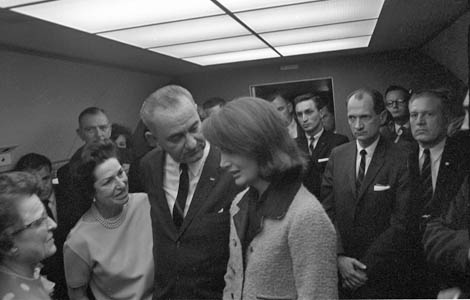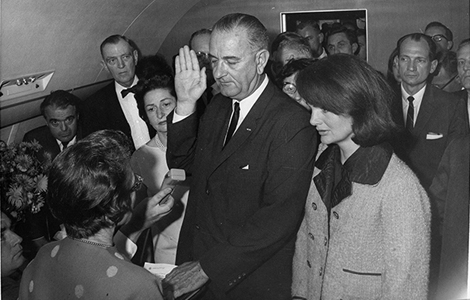November 22, 1963: Air Force One’s Worst Day
Inside the president’s airplane in the frantic hours after JFK’s assassination
/https://tf-cmsv2-smithsonianmag-media.s3.amazonaws.com/filer/0a/27/0a27e450-8f6a-483a-b37f-84aeef604ead/vc-137-1_air_force_one.jpg)
There have been other presidential airplanes, but the one known, prosaically, by its serial number — SAM 26000 — is the most famous by far. It’s the one Jackie Kennedy had a hand in designing, the first built specifically to transport the U.S. head of state around the world, and the scene, 50 years ago, of some of the most emotional moments in presidential history.
On November 22, 1963, 28 people crowded into the staff room of this specially outfitted Boeing 707 to watch Lyndon Johnson take the oath of office, with the widow of assassinated President John F. Kennedy standing at his side. Just inside the rear door of the aircraft, in the aft galley, sat her husband’s coffin. The presidential party had arrived in Dallas only three hours earlier, on this same airplane.
The sites associated with that awful day have become part of American lore — Dealey Plaza, the book depository, the grassy knoll. For this 50th anniversary, two writers turned their attention to the airplane that carried one U.S. president to Dallas and brought a different one back to Washington on the same day. Washingtonian editor Garrett Graff has written a slim book, Angel is Airborne, set inside SAM 26000 on the day of the assassination (you can read it here). Esquire writer Chris Jones covers the same subject in his article “The Flight From Dallas.” Both rely heavily on previously published accounts, but they still make riveting reading, if only to remind us of all the accidents of timing that led some 40 people — including future LBJ aides Jack Valenti and Bill Moyers — to be on board the airplane during those climactic hours.
Among them was the man who took the pictures of LBJ’s hastily arranged swearing-in. As a White House photographer, Cecil Stoughton had shot many of the iconic images we associate with Kennedy’s Camelot. Before that, he had been a wartime photographer in Guadalcanal, and had documented the early space program from Cape Canaveral (he was on the recovery ship when the monkeys Able and Baker splashed down in 1959).
At the time of the assassination, Stoughton was riding in the motorcade several cars back from the president. He heard shots, but couldn’t see what had happened. In fact, it wasn’t until he arrived at Parkland Hospital that he learned Kennedy had been hit and was likely dead. Then, as Stoughton recalled it years later in an oral history interview, as he was standing around at the hospital:
Out of the corner of my eye I saw Mr. Johnson, Mrs. Johnson, Rufus Youngblood and a couple of other people making mad dashes for the door, which was behind me….I kind of nodded. “Where’s he going?” And said “The president’s going to Washington.” That was my clue that the president I came with was no longer there, and I said “Well, so am I.”
Stoughton climbed into a car and raced to Love Field, where the presidential airplane was waiting on the tarmac.
A policeman drove us out. There were four of us in the car. We made a mad dash to the airport using a different route because you didn’t know which way they had gone, really, and they were under security cover anyway, no radios. So we came up to Love Field and we came in the wrong entrance. It turned out that we came in towards the active runway and, actually, we crossed the active runway and came barreling down this active runway, under the guns, we found out later, of security guys who had been posted there just in the last five minutes. We almost got shot, because, “What’s this black car?” It might be official and all that, but here it comes charging towards Air Force One.
The photographer rushed up to pilot Jim Swindal, whom he knew, and got the okay to come aboard. Within an hour, with the plane still on the ground, Stoughton took some of the most recognized photos of the 20th century while standing on a couch looking down. In all the pictures, according to Graff, he was careful to frame Mrs. Kennedy from the waist up so the blood stains on her skirt wouldn’t show.
Stoughton didn’t fly back to Washington with the new president — he rushed off to have his negatives developed instead.
By the time they were dried and we’d made all selections and so forth, the plane had landed at Andrews one hour and fifty-two or -three minutes later; fastest time in history, I guess, from Dallas to Andrews because they got into a tremendous tail wind. By the time they got there and they were taxiing on the ground, someone told me was on the plane that they put the pictures on the screen. AP had moved them. They put them on the screen and the new President then saw himself being sworn in just two hours ago.
Today SAM26000 is retired and on display at the National Museum of the Air Force in Dayton, Ohio. For the 50th anniversary of the fateful flight to Dallas, the museum asked photographer Lyle Jansma, who also created our gallery of inside-the-cockpit views, to make a virtual tour of the inside of the historic airplane.
Look around the (since remodeled) room where LBJ was sworn in, from the photographer’s vantage point:
Or take the full tour of the airplane:

